service schedule DODGE VIPER 2008 ZB II / 2.G Owners Manual
[x] Cancel search | Manufacturer: DODGE, Model Year: 2008, Model line: VIPER, Model: DODGE VIPER 2008 ZB II / 2.GPages: 303, PDF Size: 2.65 MB
Page 198 of 303
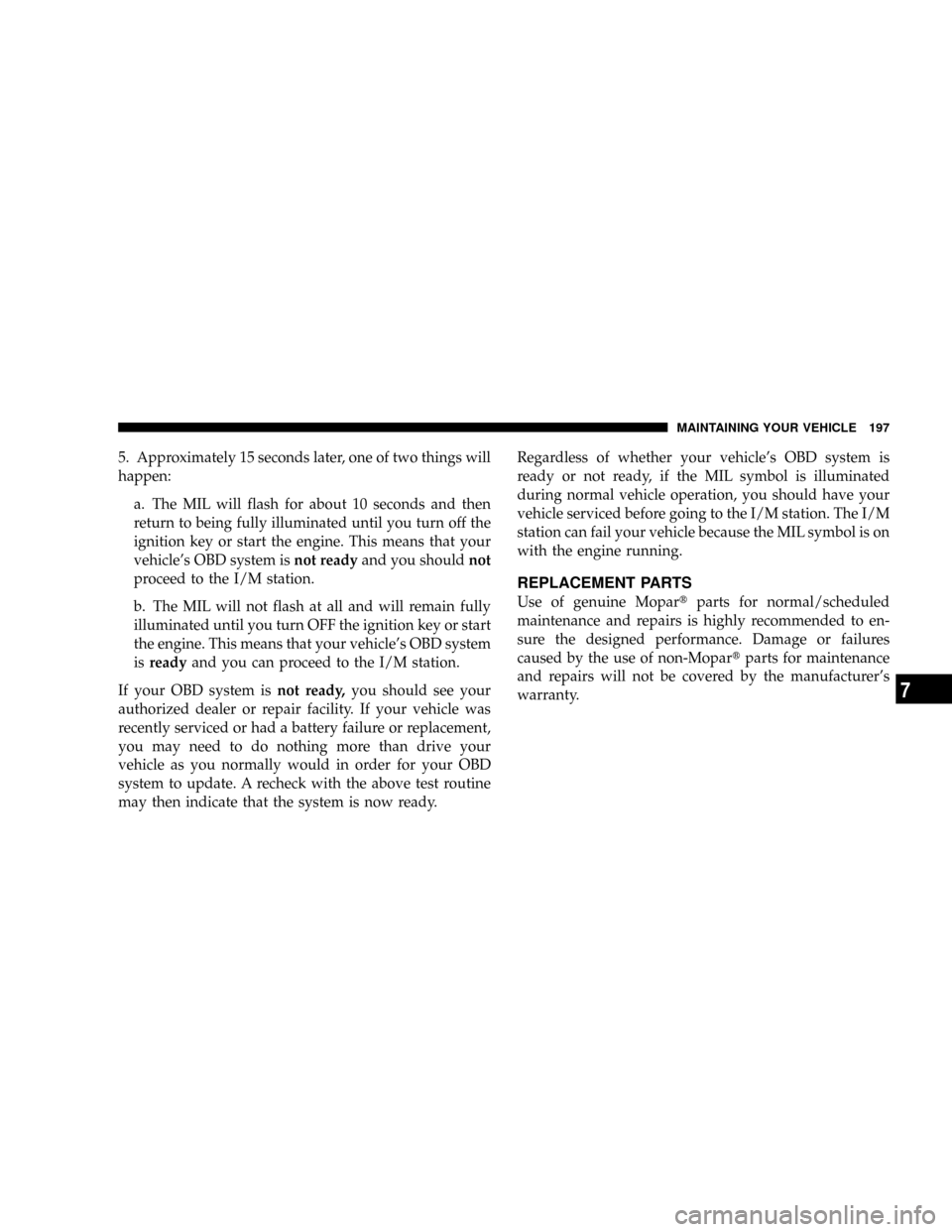
5. Approximately 15 seconds later, one of two things will
happen:
a. The MIL will flash for about 10 seconds and then
return to being fully illuminated until you turn off the
ignition key or start the engine. This means that your
vehicle's OBD system isnot readyand you shouldnot
proceed to the I/M station.
b. The MIL will not flash at all and will remain fully
illuminated until you turn OFF the ignition key or start
the engine. This means that your vehicle's OBD system
isreadyand you can proceed to the I/M station.
If your OBD system isnot ready,you should see your
authorized dealer or repair facility. If your vehicle was
recently serviced or had a battery failure or replacement,
you may need to do nothing more than drive your
vehicle as you normally would in order for your OBD
system to update. A recheck with the above test routine
may then indicate that the system is now ready.Regardless of whether your vehicle's OBD system is
ready or not ready, if the MIL symbol is illuminated
during normal vehicle operation, you should have your
vehicle serviced before going to the I/M station. The I/M
station can fail your vehicle because the MIL symbol is on
with the engine running.
REPLACEMENT PARTS
Use of genuine Mopartparts for normal/scheduled
maintenance and repairs is highly recommended to en-
sure the designed performance. Damage or failures
caused by the use of non-Mopartparts for maintenance
and repairs will not be covered by the manufacturer's
warranty.
MAINTAINING YOUR VEHICLE 197
7
Page 201 of 303
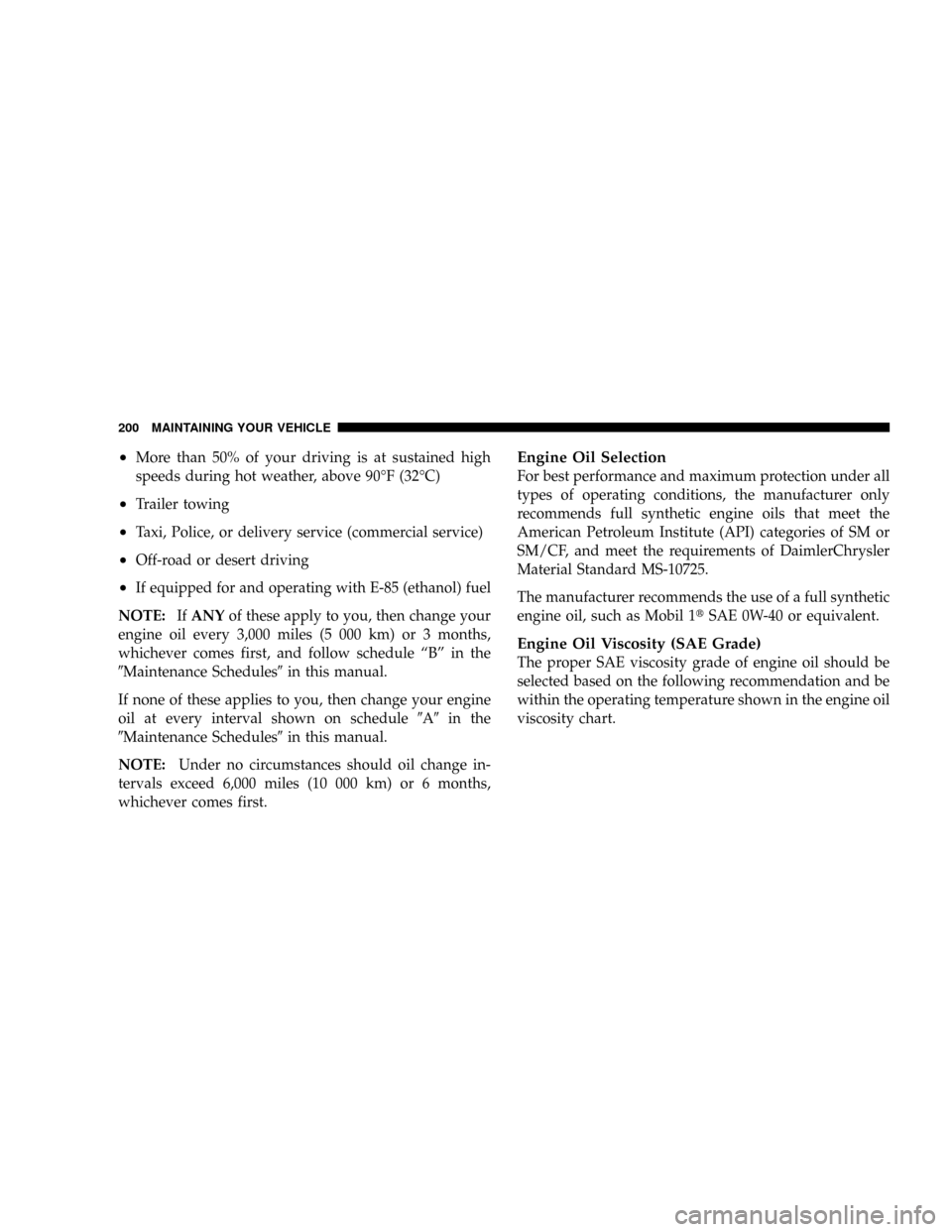
²More than 50% of your driving is at sustained high
speeds during hot weather, above 90ÉF (32ÉC)
²Trailer towing
²Taxi, Police, or delivery service (commercial service)
²Off-road or desert driving
²If equipped for and operating with E-85 (ethanol) fuel
NOTE:IfANYof these apply to you, then change your
engine oil every 3,000 miles (5 000 km) or 3 months,
whichever comes first, and follow schedule ªBº in the
9Maintenance Schedules9in this manual.
If none of these applies to you, then change your engine
oil at every interval shown on schedule9A9in the
9Maintenance Schedules9in this manual.
NOTE:Under no circumstances should oil change in-
tervals exceed 6,000 miles (10 000 km) or 6 months,
whichever comes first.
Engine Oil Selection
For best performance and maximum protection under all
types of operating conditions, the manufacturer only
recommends full synthetic engine oils that meet the
American Petroleum Institute (API) categories of SM or
SM/CF, and meet the requirements of DaimlerChrysler
Material Standard MS-10725.
The manufacturer recommends the use of a full synthetic
engine oil, such as Mobil 1tSAE 0W-40 or equivalent.
Engine Oil Viscosity (SAE Grade)
The proper SAE viscosity grade of engine oil should be
selected based on the following recommendation and be
within the operating temperature shown in the engine oil
viscosity chart.
200 MAINTAINING YOUR VEHICLE
Page 215 of 303
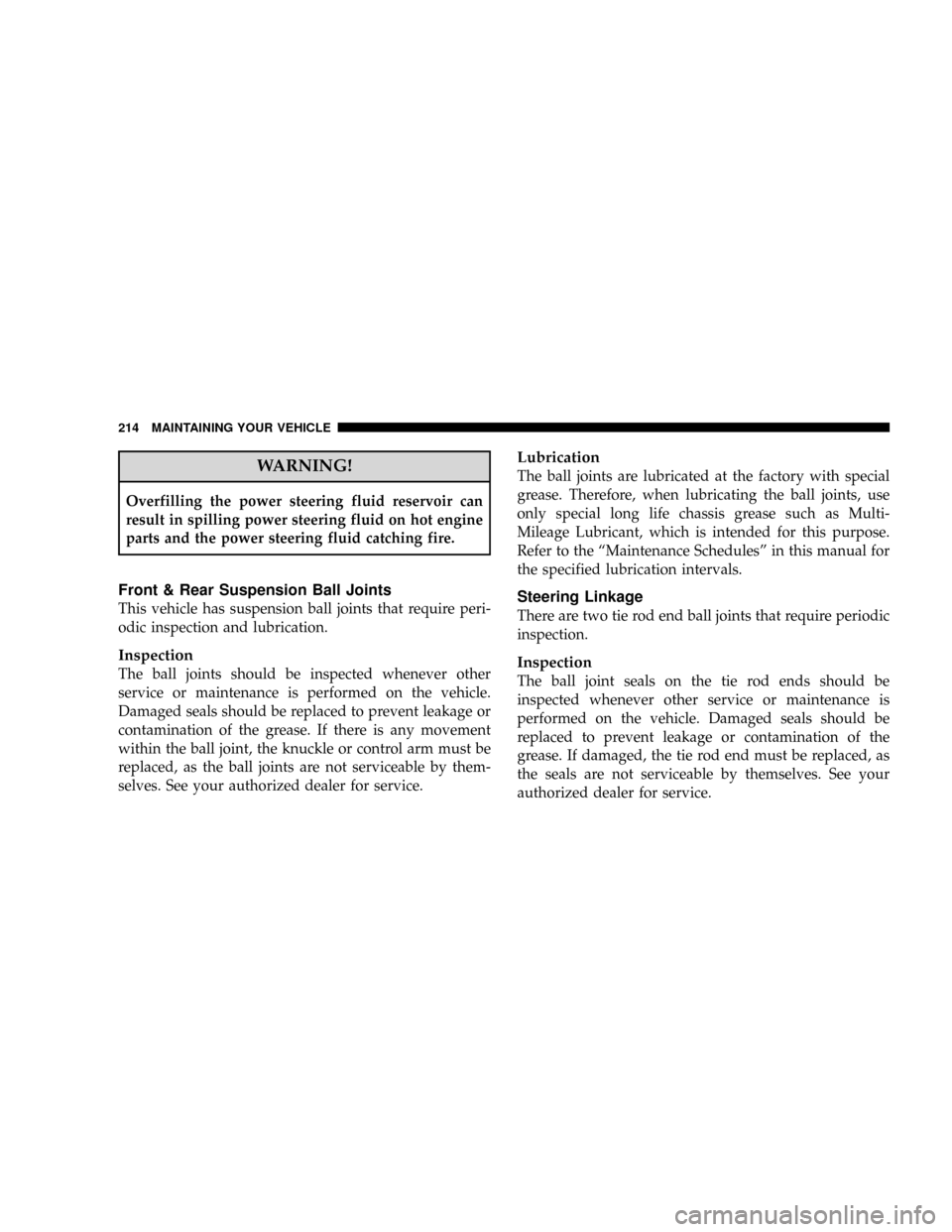
WARNING!
Overfilling the power steering fluid reservoir can
result in spilling power steering fluid on hot engine
parts and the power steering fluid catching fire.
Front & Rear Suspension Ball Joints
This vehicle has suspension ball joints that require peri-
odic inspection and lubrication.
Inspection
The ball joints should be inspected whenever other
service or maintenance is performed on the vehicle.
Damaged seals should be replaced to prevent leakage or
contamination of the grease. If there is any movement
within the ball joint, the knuckle or control arm must be
replaced, as the ball joints are not serviceable by them-
selves. See your authorized dealer for service.
Lubrication
The ball joints are lubricated at the factory with special
grease. Therefore, when lubricating the ball joints, use
only special long life chassis grease such as Multi-
Mileage Lubricant, which is intended for this purpose.
Refer to the ªMaintenance Schedulesº in this manual for
the specified lubrication intervals.
Steering Linkage
There are two tie rod end ball joints that require periodic
inspection.
Inspection
The ball joint seals on the tie rod ends should be
inspected whenever other service or maintenance is
performed on the vehicle. Damaged seals should be
replaced to prevent leakage or contamination of the
grease. If damaged, the tie rod end must be replaced, as
the seals are not serviceable by themselves. See your
authorized dealer for service.
214 MAINTAINING YOUR VEHICLE
Page 226 of 303
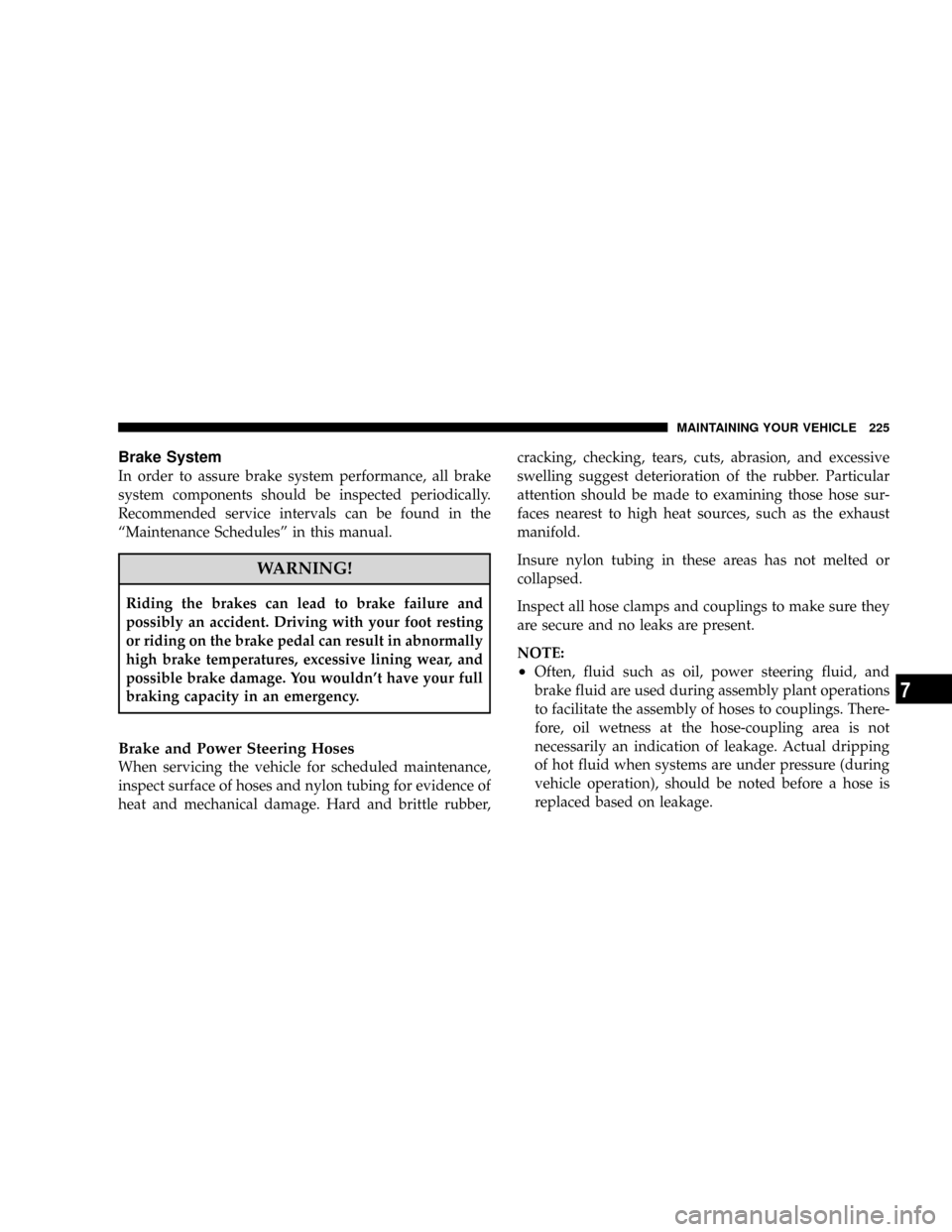
Brake System
In order to assure brake system performance, all brake
system components should be inspected periodically.
Recommended service intervals can be found in the
ªMaintenance Schedulesº in this manual.
WARNING!
Riding the brakes can lead to brake failure and
possibly an accident. Driving with your foot resting
or riding on the brake pedal can result in abnormally
high brake temperatures, excessive lining wear, and
possible brake damage. You wouldn't have your full
braking capacity in an emergency.
Brake and Power Steering Hoses
When servicing the vehicle for scheduled maintenance,
inspect surface of hoses and nylon tubing for evidence of
heat and mechanical damage. Hard and brittle rubber,cracking, checking, tears, cuts, abrasion, and excessive
swelling suggest deterioration of the rubber. Particular
attention should be made to examining those hose sur-
faces nearest to high heat sources, such as the exhaust
manifold.
Insure nylon tubing in these areas has not melted or
collapsed.
Inspect all hose clamps and couplings to make sure they
are secure and no leaks are present.
NOTE:
²Often, fluid such as oil, power steering fluid, and
brake fluid are used during assembly plant operations
to facilitate the assembly of hoses to couplings. There-
fore, oil wetness at the hose-coupling area is not
necessarily an indication of leakage. Actual dripping
of hot fluid when systems are under pressure (during
vehicle operation), should be noted before a hose is
replaced based on leakage.
MAINTAINING YOUR VEHICLE 225
7
Page 228 of 303
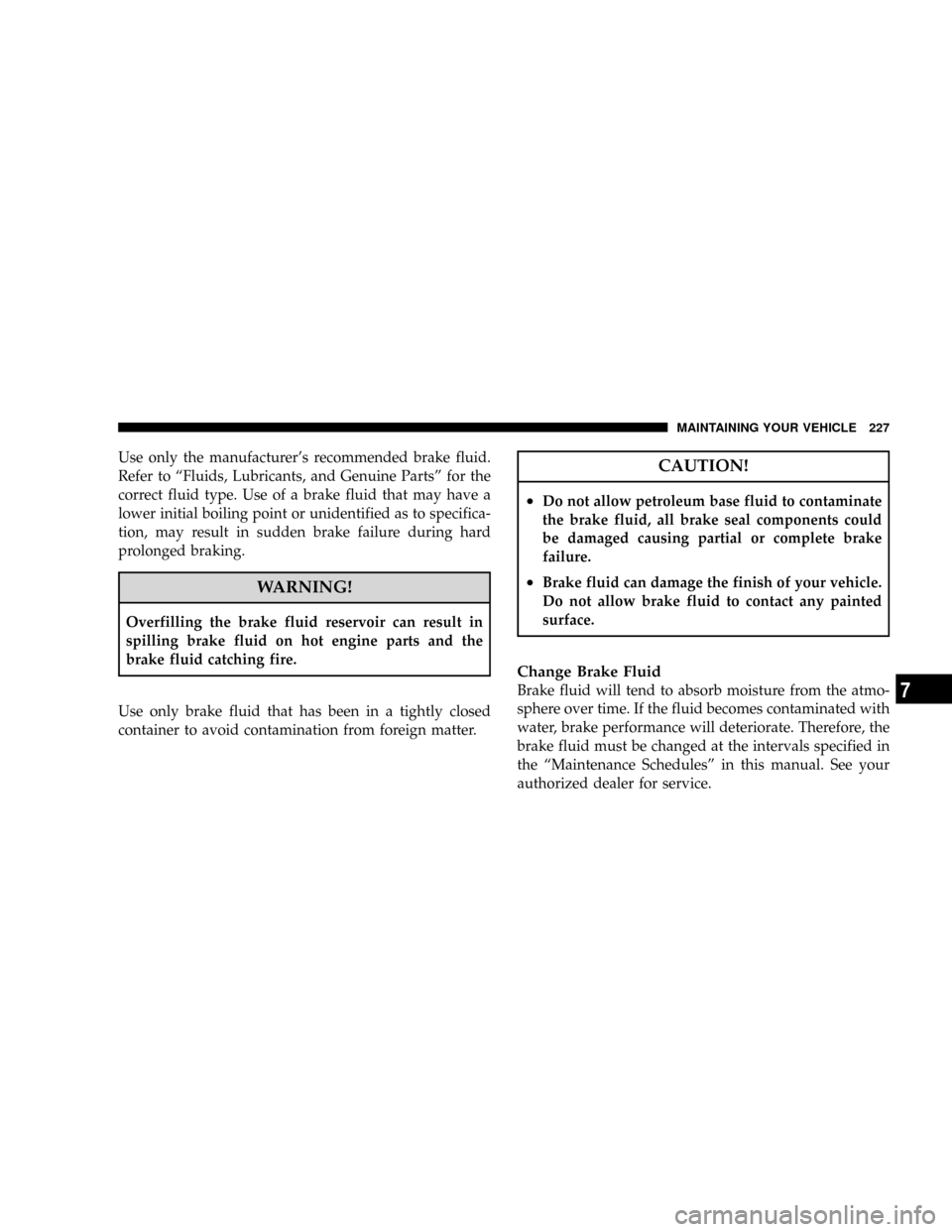
Use only the manufacturer's recommended brake fluid.
Refer to ªFluids, Lubricants, and Genuine Partsº for the
correct fluid type. Use of a brake fluid that may have a
lower initial boiling point or unidentified as to specifica-
tion, may result in sudden brake failure during hard
prolonged braking.
WARNING!
Overfilling the brake fluid reservoir can result in
spilling brake fluid on hot engine parts and the
brake fluid catching fire.
Use only brake fluid that has been in a tightly closed
container to avoid contamination from foreign matter.
CAUTION!
²Do not allow petroleum base fluid to contaminate
the brake fluid, all brake seal components could
be damaged causing partial or complete brake
failure.
²Brake fluid can damage the finish of your vehicle.
Do not allow brake fluid to contact any painted
surface.
Change Brake Fluid
Brake fluid will tend to absorb moisture from the atmo-
sphere over time. If the fluid becomes contaminated with
water, brake performance will deteriorate. Therefore, the
brake fluid must be changed at the intervals specified in
the ªMaintenance Schedulesº in this manual. See your
authorized dealer for service.
MAINTAINING YOUR VEHICLE 227
7
Page 229 of 303
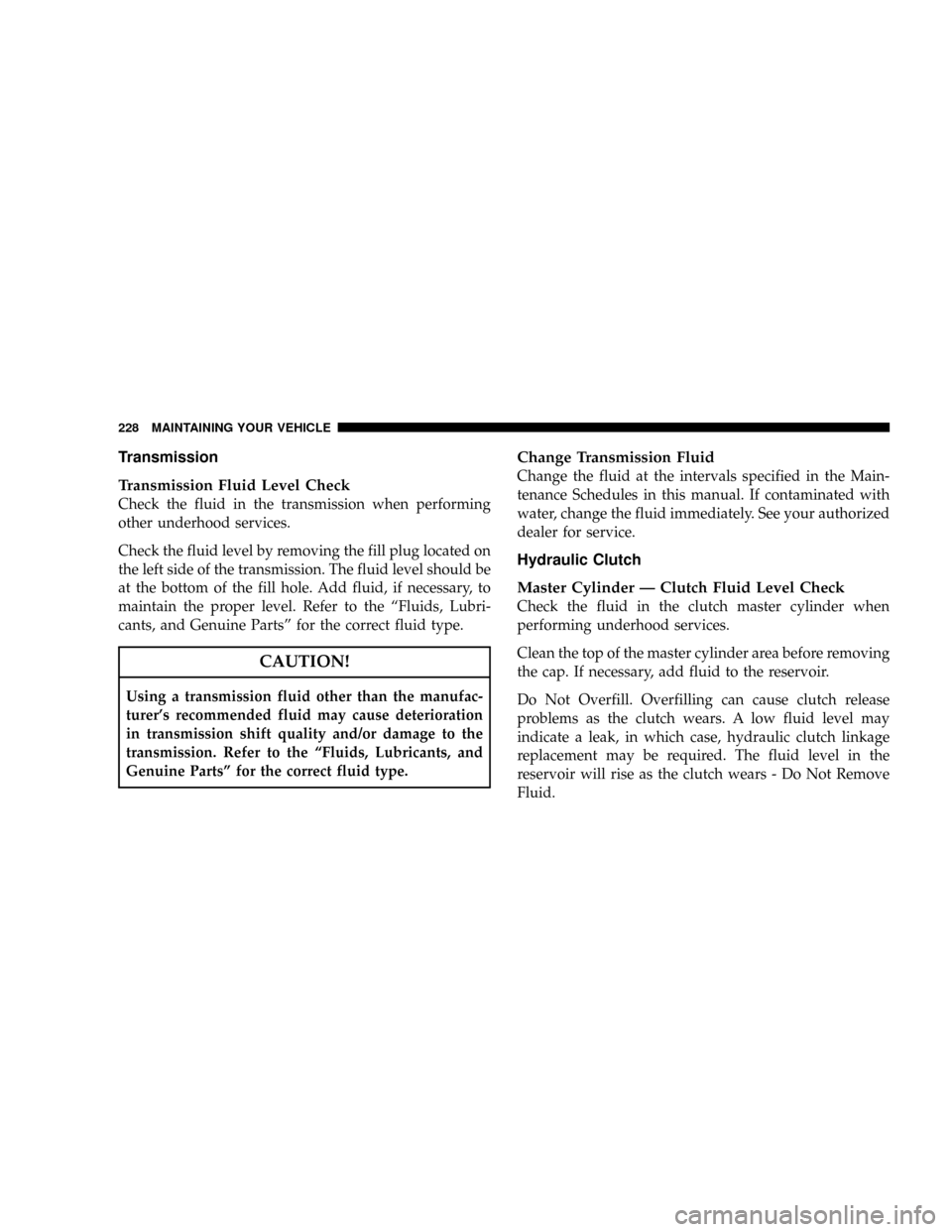
Transmission
Transmission Fluid Level Check
Check the fluid in the transmission when performing
other underhood services.
Check the fluid level by removing the fill plug located on
the left side of the transmission. The fluid level should be
at the bottom of the fill hole. Add fluid, if necessary, to
maintain the proper level. Refer to the ªFluids, Lubri-
cants, and Genuine Partsº for the correct fluid type.
CAUTION!
Using a transmission fluid other than the manufac-
turer's recommended fluid may cause deterioration
in transmission shift quality and/or damage to the
transmission. Refer to the ªFluids, Lubricants, and
Genuine Partsº for the correct fluid type.
Change Transmission Fluid
Change the fluid at the intervals specified in the Main-
tenance Schedules in this manual. If contaminated with
water, change the fluid immediately. See your authorized
dealer for service.
Hydraulic Clutch
Master Cylinder Ð Clutch Fluid Level Check
Check the fluid in the clutch master cylinder when
performing underhood services.
Clean the top of the master cylinder area before removing
the cap. If necessary, add fluid to the reservoir.
Do Not Overfill. Overfilling can cause clutch release
problems as the clutch wears. A low fluid level may
indicate a leak, in which case, hydraulic clutch linkage
replacement may be required. The fluid level in the
reservoir will rise as the clutch wears - Do Not Remove
Fluid.
228 MAINTAINING YOUR VEHICLE
Page 230 of 303
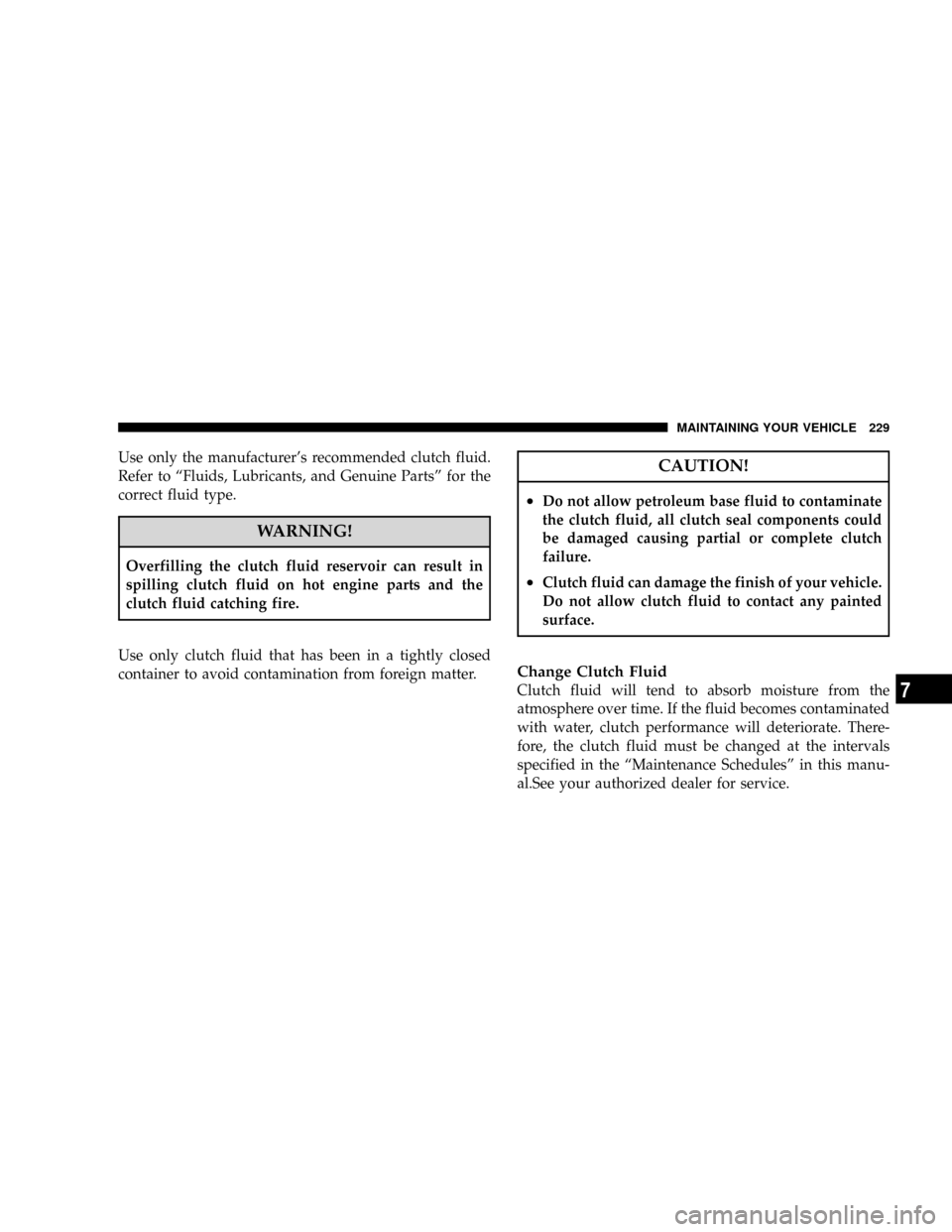
Use only the manufacturer's recommended clutch fluid.
Refer to ªFluids, Lubricants, and Genuine Partsº for the
correct fluid type.
WARNING!
Overfilling the clutch fluid reservoir can result in
spilling clutch fluid on hot engine parts and the
clutch fluid catching fire.
Use only clutch fluid that has been in a tightly closed
container to avoid contamination from foreign matter.
CAUTION!
²Do not allow petroleum base fluid to contaminate
the clutch fluid, all clutch seal components could
be damaged causing partial or complete clutch
failure.
²Clutch fluid can damage the finish of your vehicle.
Do not allow clutch fluid to contact any painted
surface.
Change Clutch Fluid
Clutch fluid will tend to absorb moisture from the
atmosphere over time. If the fluid becomes contaminated
with water, clutch performance will deteriorate. There-
fore, the clutch fluid must be changed at the intervals
specified in the ªMaintenance Schedulesº in this manu-
al.See your authorized dealer for service.
MAINTAINING YOUR VEHICLE 229
7
Page 231 of 303
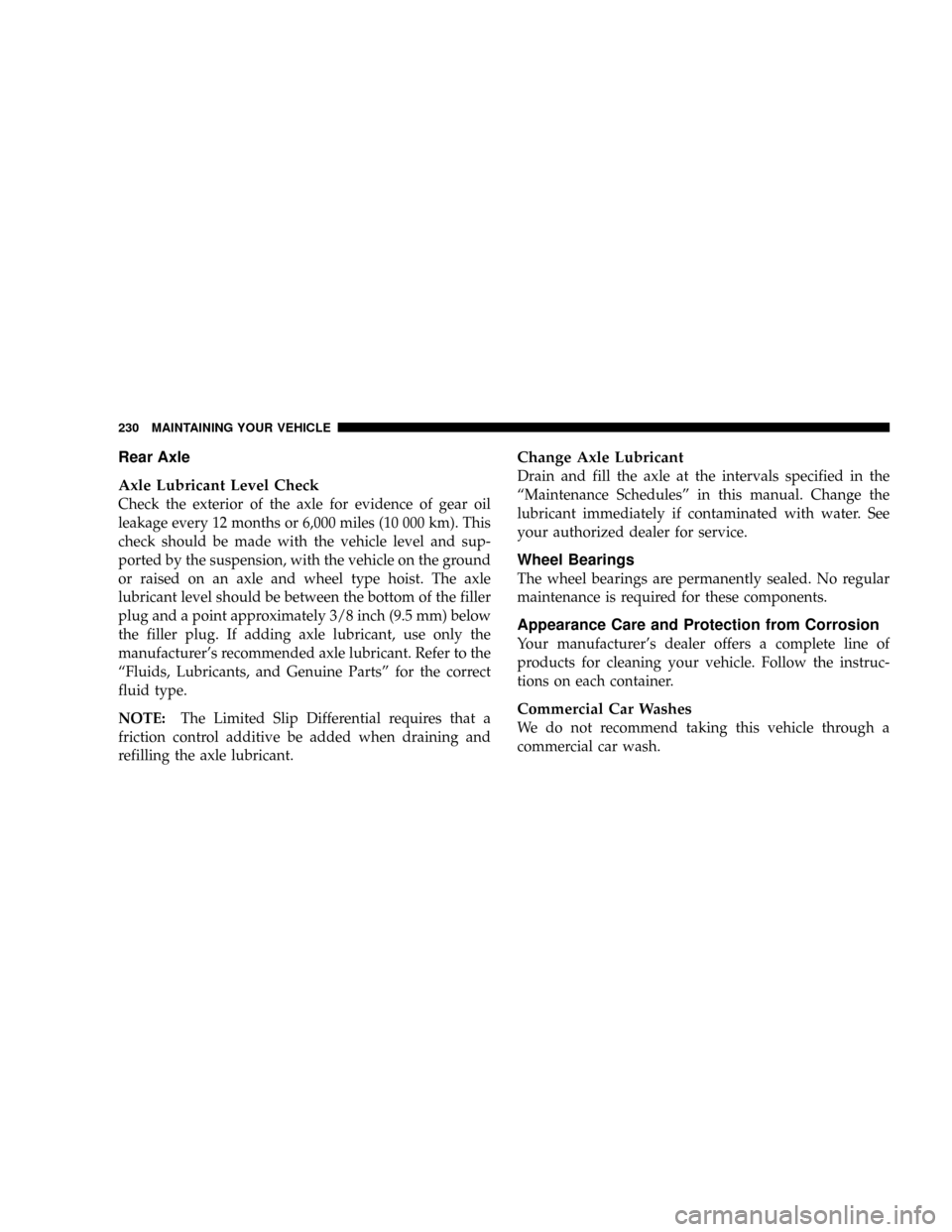
Rear Axle
Axle Lubricant Level Check
Check the exterior of the axle for evidence of gear oil
leakage every 12 months or 6,000 miles (10 000 km). This
check should be made with the vehicle level and sup-
ported by the suspension, with the vehicle on the ground
or raised on an axle and wheel type hoist. The axle
lubricant level should be between the bottom of the filler
plug and a point approximately 3/8 inch (9.5 mm) below
the filler plug. If adding axle lubricant, use only the
manufacturer's recommended axle lubricant. Refer to the
ªFluids, Lubricants, and Genuine Partsº for the correct
fluid type.
NOTE:The Limited Slip Differential requires that a
friction control additive be added when draining and
refilling the axle lubricant.
Change Axle Lubricant
Drain and fill the axle at the intervals specified in the
ªMaintenance Schedulesº in this manual. Change the
lubricant immediately if contaminated with water. See
your authorized dealer for service.
Wheel Bearings
The wheel bearings are permanently sealed. No regular
maintenance is required for these components.
Appearance Care and Protection from Corrosion
Your manufacturer's dealer offers a complete line of
products for cleaning your vehicle. Follow the instruc-
tions on each container.
Commercial Car Washes
We do not recommend taking this vehicle through a
commercial car wash.
230 MAINTAINING YOUR VEHICLE
Page 257 of 303
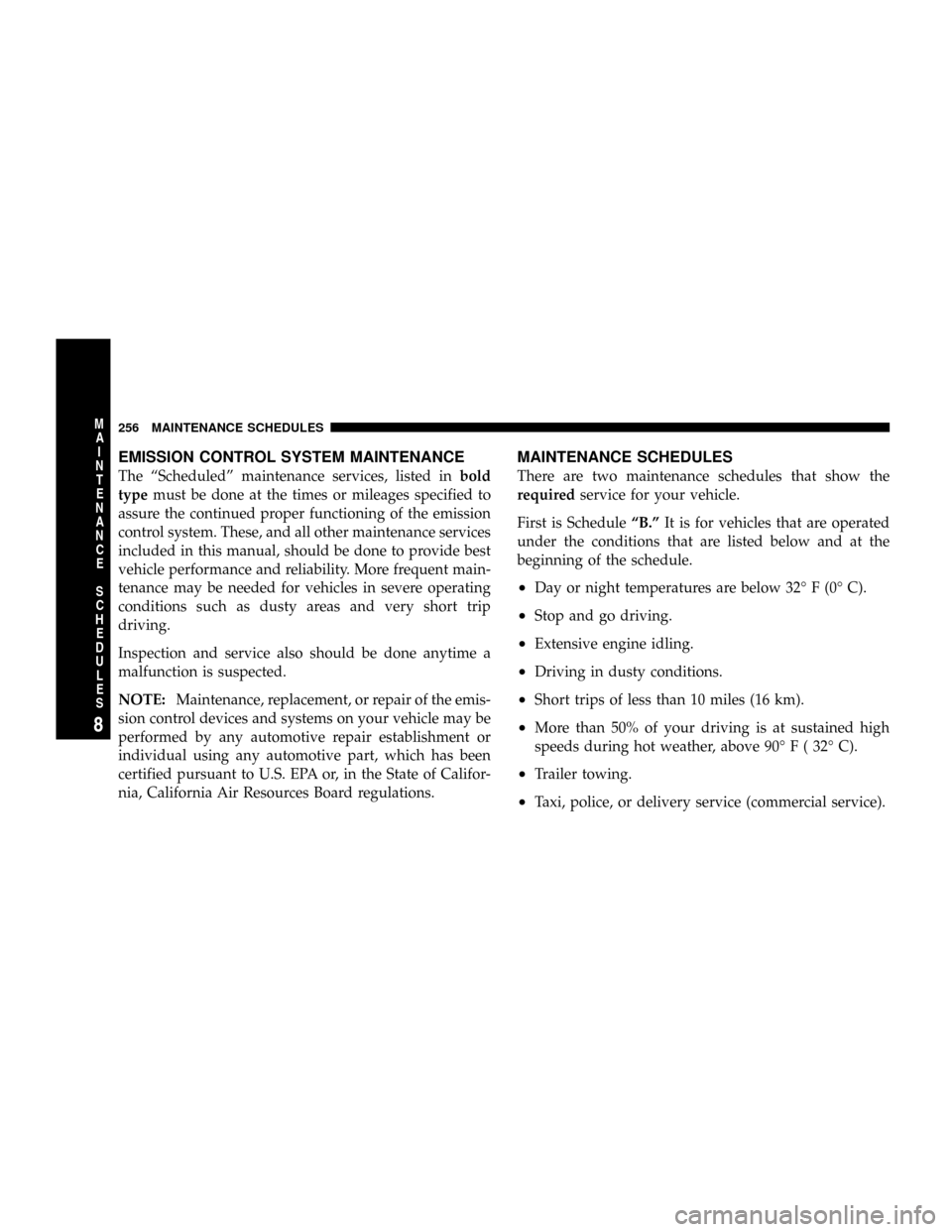
EMISSION CONTROL SYSTEM MAINTENANCE
The ªScheduledº maintenance services, listed inbold
typemust be done at the times or mileages specified to
assure the continued proper functioning of the emission
control system. These, and all other maintenance services
included in this manual, should be done to provide best
vehicle performance and reliability. More frequent main-
tenance may be needed for vehicles in severe operating
conditions such as dusty areas and very short trip
driving.
Inspection and service also should be done anytime a
malfunction is suspected.
NOTE:Maintenance, replacement, or repair of the emis-
sion control devices and systems on your vehicle may be
performed by any automotive repair establishment or
individual using any automotive part, which has been
certified pursuant to U.S. EPA or, in the State of Califor-
nia, California Air Resources Board regulations.
MAINTENANCE SCHEDULES
There are two maintenance schedules that show the
requiredservice for your vehicle.
First is ScheduleªB.ºIt is for vehicles that are operated
under the conditions that are listed below and at the
beginning of the schedule.
²Day or night temperatures are below 32É F (0É C).
²Stop and go driving.
²Extensive engine idling.
²Driving in dusty conditions.
²Short trips of less than 10 miles (16 km).
²More than 50% of your driving is at sustained high
speeds during hot weather, above 90É F ( 32É C).
²Trailer towing.
²Taxi, police, or delivery service (commercial service).
256 MAINTENANCE SCHEDULES
8
M
A
I
N
T
E
N
A
N
C
E
S
C
H
E
D
U
L
E
S
Page 260 of 303
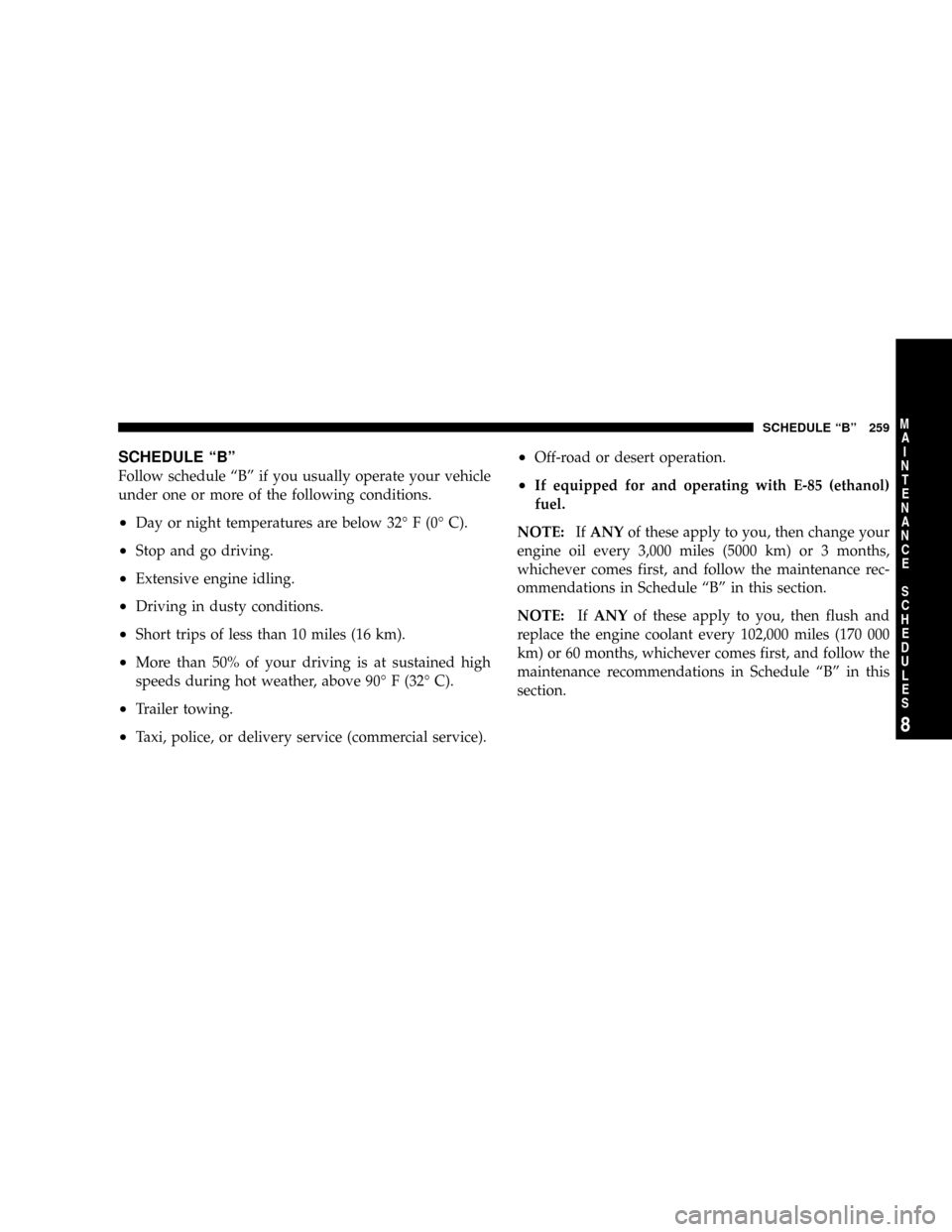
SCHEDULE ªBº
Follow schedule ªBº if you usually operate your vehicle
under one or more of the following conditions.
²Day or night temperatures are below 32É F (0É C).
²Stop and go driving.
²Extensive engine idling.
²Driving in dusty conditions.
²Short trips of less than 10 miles (16 km).
²More than 50% of your driving is at sustained high
speeds during hot weather, above 90É F (32É C).
²Trailer towing.
²Taxi, police, or delivery service (commercial service).
²Off-road or desert operation.
²If equipped for and operating with E-85 (ethanol)
fuel.
NOTE:IfANYof these apply to you, then change your
engine oil every 3,000 miles (5000 km) or 3 months,
whichever comes first, and follow the maintenance rec-
ommendations in Schedule ªBº in this section.
NOTE:IfANYof these apply to you, then flush and
replace the engine coolant every 102,000 miles (170 000
km) or 60 months, whichever comes first, and follow the
maintenance recommendations in Schedule ªBº in this
section.
SCHEDULE ªBº 259
8
M
A
I
N
T
E
N
A
N
C
E
S
C
H
E
D
U
L
E
S